Everett M. Dirksen United States Courthouse - Site of the Trial of the Chicago 8
Introduction
Text-to-speech Audio
The Everett M. Dirksen United States Courthouse was host to the trial of the most notorious of the protestors at the 1968 Democratic National Convention. The building is named for Everett McKinley Dirksen, who served Illinois as a U.S. Representative from 1933-1949 and U.S. Senator from 1951-1969 and was built by German born architect Mies van der Rohe. Mies' style was referred to as "skin-and-bones"; a modern, simple style composed of steel beams and lots of glass. Mies was one of the first industrial architects to utilize glass in large sections, while today, glass has become one of the most used building materials.
The trial of the Chicago 8 began inside the Dirksen building on September 24, 1969 and lasted over four months. Jerry Rubin, Abbie Hoffman, Tom Hayden, Rennie Davis, Bobby Seale, Lee Weiner, John Froines and David Dellinger were the first protestors charged under the Anti-Riot Act, officially known as Section 18 United States Code § 2101, 2102, which ascribed criminal penalties for acts committed in civil disorders. The Anti-Riot Act was attached to the Civil Rights Act of 1968 despite serving no purpose in advancing civil rights. The Dirksen building continues to house the Northern District of Illinois federal circuit court and federal bankruptcy court, as well as the Seventh Circuit appellate division.
Images
Dirksen Building Poster
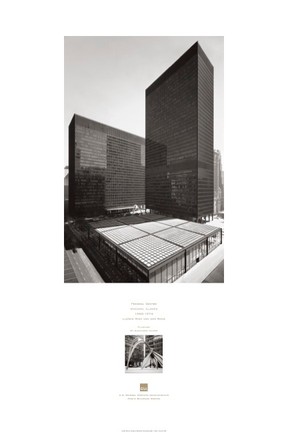
We will not be denied our right to dissent!
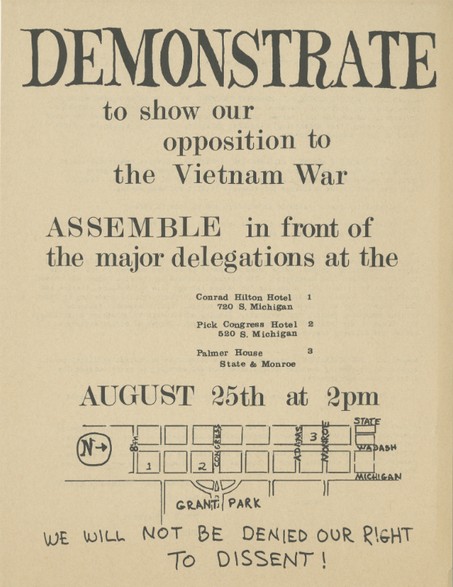
Face of the Enemy Poster featuring Mayor Daley, President Nixon and Judge Hoffman
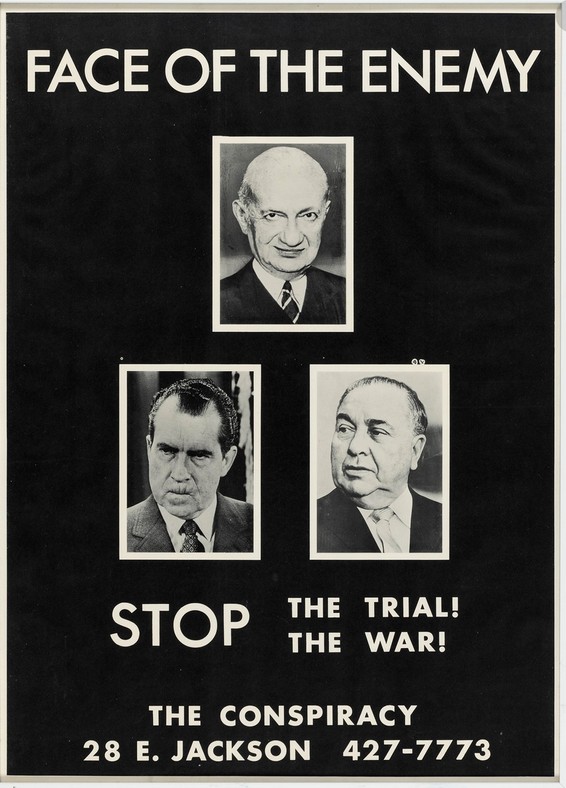
The Chicago Eight: (top L-R) Jerry Rubin, Abbie Hoffman,Tom Hayden, Rennie Davis, Bobby Seale, Lee Weiner, John Froines and David Dellinger, circa 1968.
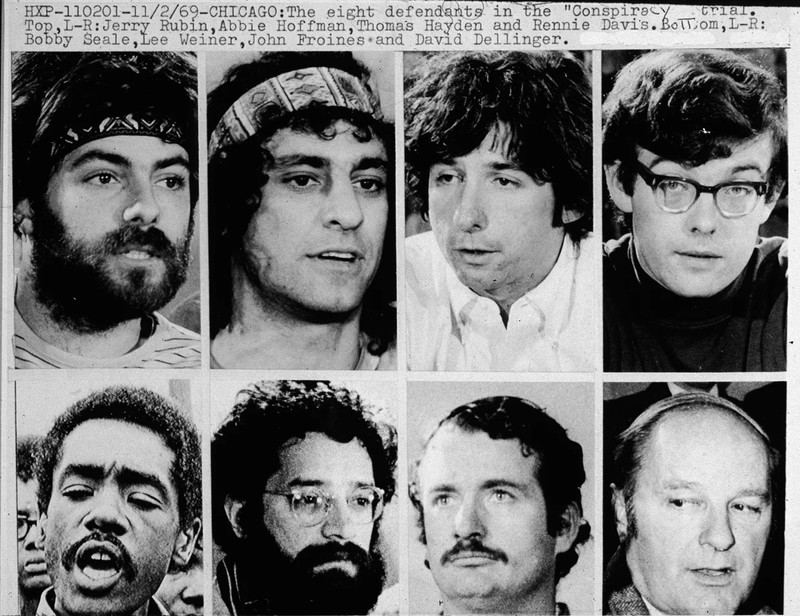
Black Panther Co-Founder Bobby Seale, Chicago 8 Codefendant
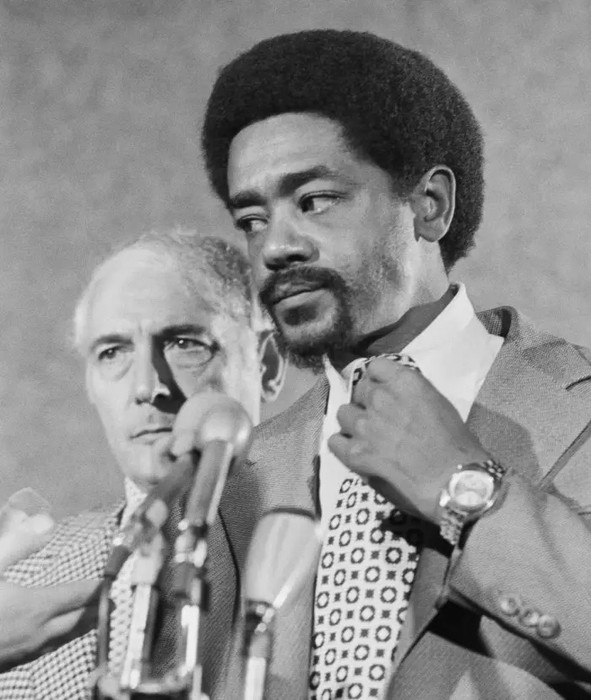
Black Panther Newsletter Cover Featuring Bobby Seale
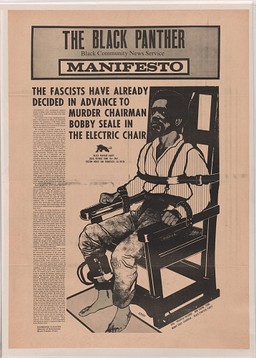
Courtroom Drawing of Bobby Seale bound and gagged by order of Judge Hoffman
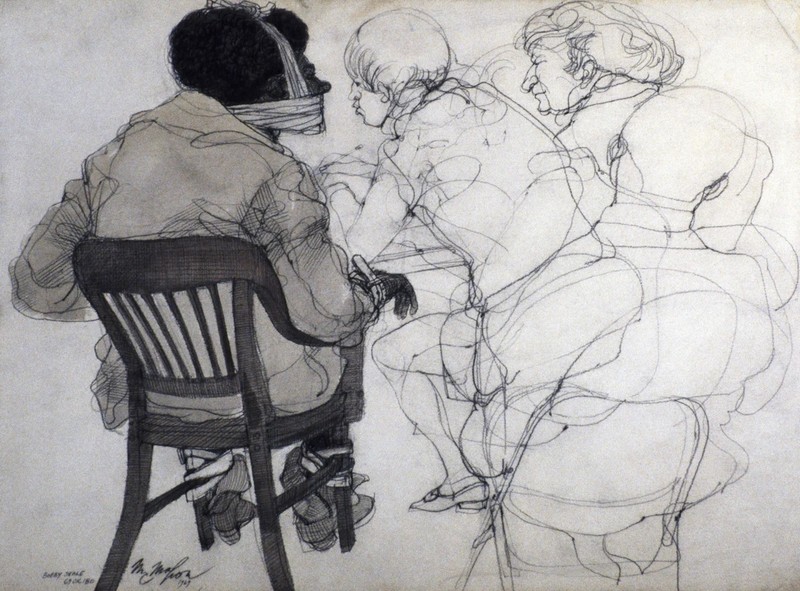
Bobby Seale attempting to write notes on a legal pad while bound and gagged in the courtroom during the Chicago Eight conspiracy trial
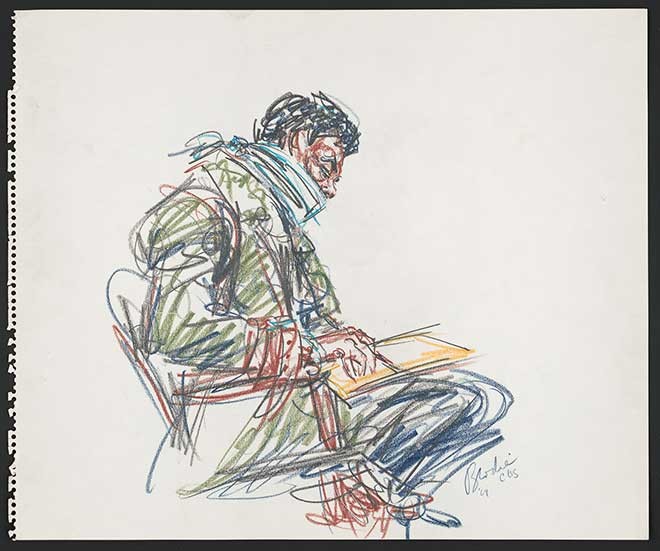
NLF Flag Tug of War
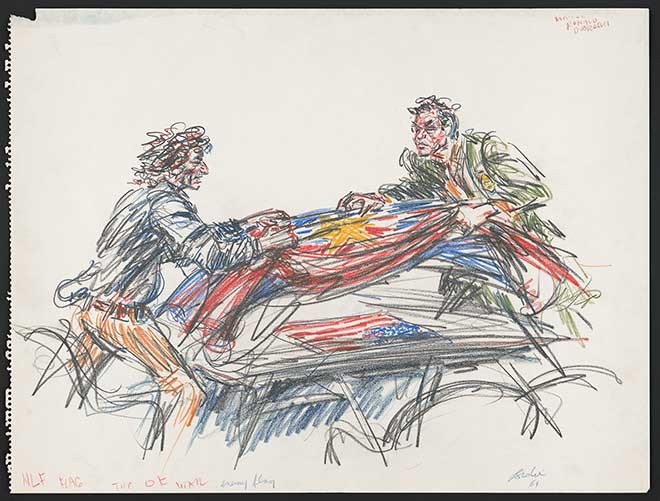
Join the Conspiracy
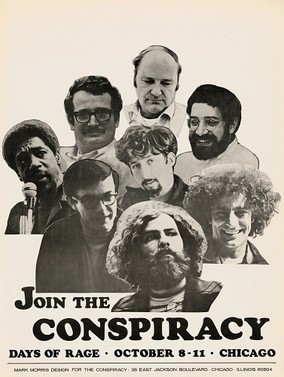
The Chicago Conspiracy vs. Washington Kangaroos: Official Pogrom
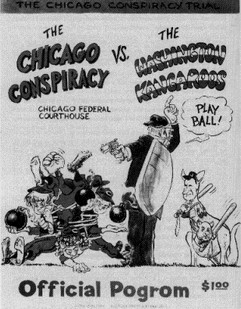
Special Event Permit Application of the National Mobilization Committee to End the War in Vietnam
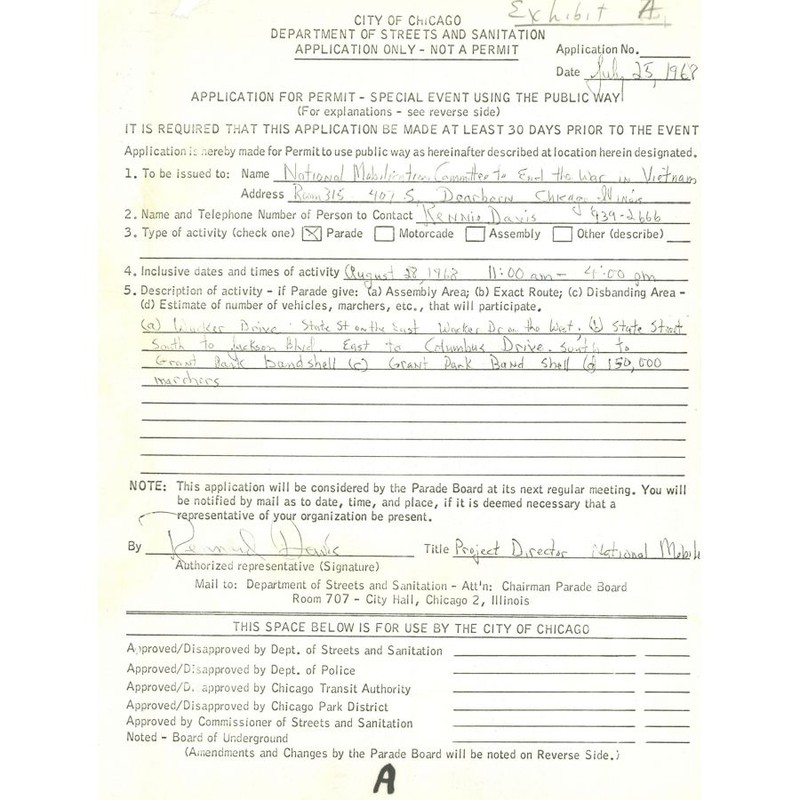
Letter from the National Mobilization Committee to End the War in Vietnam asking for the public to join them.
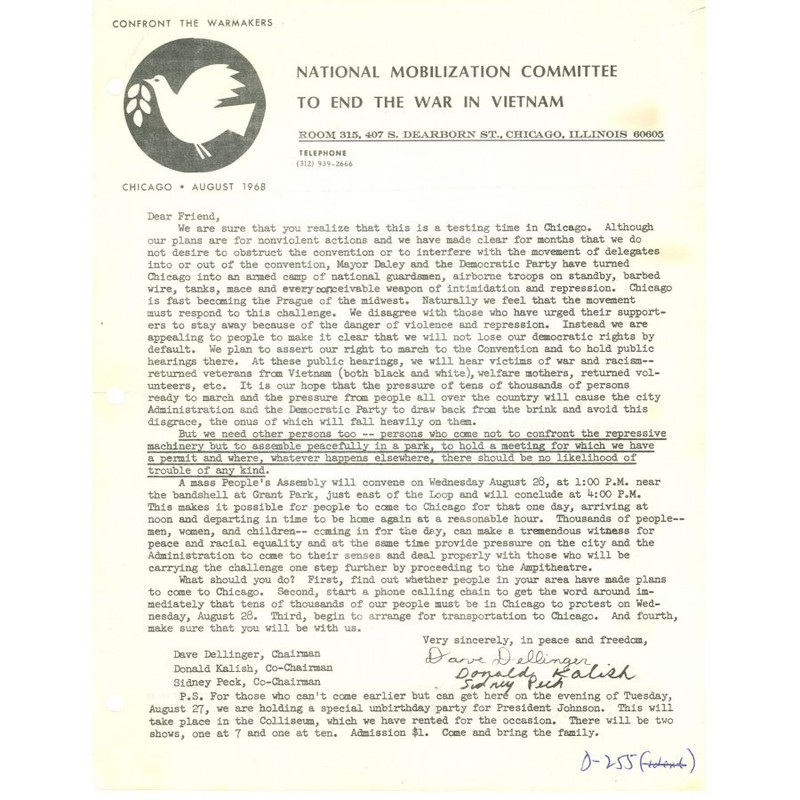
Letter from the National Mobilization Committee to End the War in Vietnam to Deputy Woods.
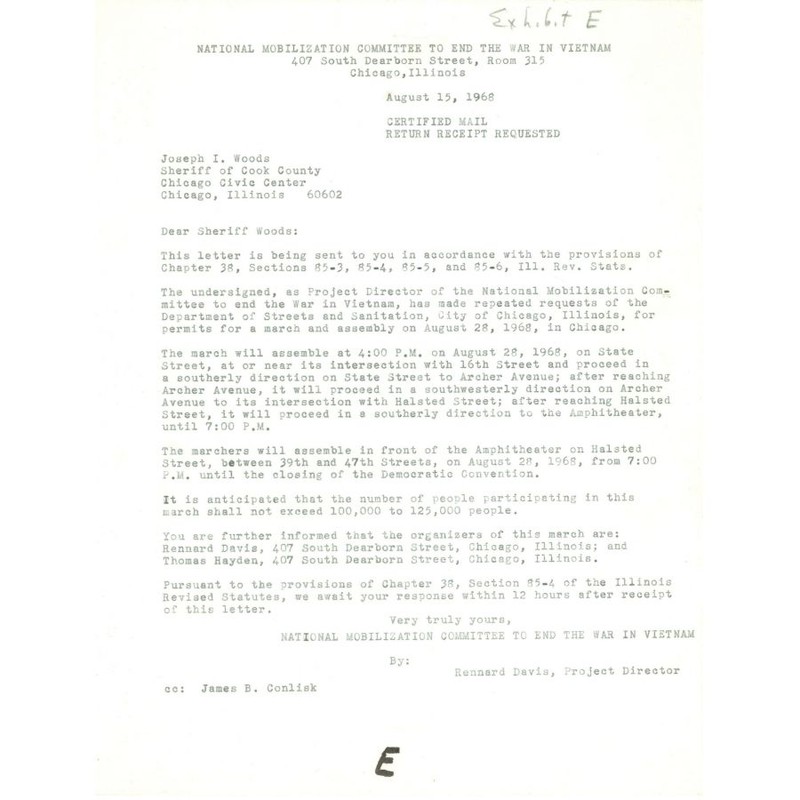
Leonard Weinglass, Rennie Davis, Abbie Hoffman, Lee Weiner, David Dellinger, John Froines, Jerry Rubin, Tom Hayden, and lawyer William Kunstler outside the courthouse in Chicago in 1969
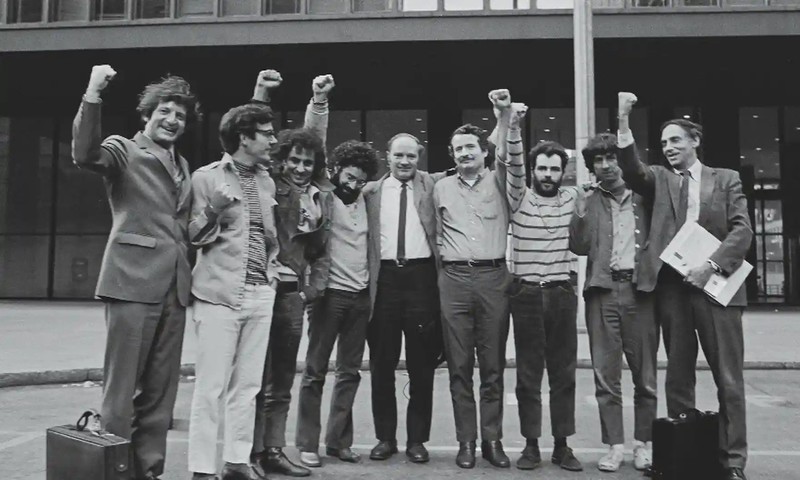
Backstory and Context
Text-to-speech Audio
The Democratic Convention held in Chicago in August of 1968 followed a particularly difficult time for the American people. Spring 1968 saw the assassinations of Martin Luther King, Jr. and Robert F. Kennedy. The summer of 1968 was filled with protests by grief stricken masses in hundreds of cities across the United States. The Vietnam War continued and many young Americans in particular believed it would never end. Chicago, as host of the 1968 Democratic National Convention, attracted the attention of demonstrators from all over the United States. Members of the National Mobilization to End the War in Vietnam, known as MOBE, sought permits prior to the convention to shut down the streets in front of the Conrad Hilton Hotel where the delegates would be staying. Members of the Youth International Party, known as the Yippies, sought permits to sleep in the parks in the area and have what they deemed a "Festival of Life" during the convention. Members of both groups, along with Bobby Seale, co-founder of the Black Panther Party, were arrested for little more than exercising their first amendment rights.
The Chicago 8 trial as it became known took place before Judge Julius Hoffman on the twenty-third floor of the Dirksen Federal Building in September 1969 through February 1970. The trial would later become known as the Chicago 7 trial once the only African American charged, Bobby Seale, as part of the conspiracy was severed from the trial for calling out Judge Hoffman's racism towards him. The Anti-Riot Act allowed the 8 demonstrators who were considered to be "leaders" and "organizers" to be charged and tried for conspiracy to incite a riot and crossing state lines to incite a riot.
MOBE coordinator Rennie Davis was a proponent of non-violent protest. While there were plans to shut down streets and inconvenience traffic, Davis had no plans for violent action. MOBE members wanted to show through their numbers on the streets of Chicago that young people across the country would not stand by while the war in Vietnam languished on with no end in sight. Yippie members, lead by Abbie Hoffman and Jerry Rubin, sought to unnerve mainstream society and show that the counter culture youth in the United States would not back the same old Democratic stalwarts who would maintain the racist, sexist status quo. Bobby Seale of the Black Panther Party would be the least involved, certainly not an organizer, as he spent only four hours in Chicago to give a speech during the convention week.
Rennie Davis, Abbie Hoffman, Jerry Rubin, Tom Hayden, David Dellinger, Lee Weiner, Bobby Seale and John Froines found themselves unprepared for the level of police violence aimed their way during the week of August 25, 1968. While they all ended up charged with conspiracy, it seemed that then Chicago Mayor Richard Daley had conspired with his police force to quash all demonstrators by any means necessary. Daley enacted an 11 pm curfew during the convention week. When the demonstrators remained in public parks past 11 pm, the police were given license to unleash tear gas on the crowd and beat them with clubs. Amongst the protestors, who were joined by the likes of poet Allen Ginsberg, author William S. Burroughs and folk singer Phil Ochs, were undercover police officers serving as bodyguards to Hoffman, Rubin and Davis. The officers would claim that Davis, the biggest advocate for non-violence, would tell his followers to "fight the pigs." Similar stories followed about the other protestors, with Tom Hayden being the first to be arrested for the crime of letting air out of a police vehicle's tires. Another undercover police officer who would later testify at the Chicago 8 trial would claim he met with Froines and Weiner, who asked him for more ammunition to use against the police and requested the officer help them with supplies to make Molotov cocktails.
The aftermath of the protests revealed that there was more support from the public to charge the officers responsible for beating protestors than for trying the Chicago 8 under the Anti-Riot Act, freshly signed into law in April of 1968, mere months before the convention. Mayor Daley was not interested in public sentiment and used a close friend who was also a federal judge to convene a grand jury and indict the Chicago 8. A true bill was returned charging all 8 with conspiracy. Daley would gain support for his push to prosecute the Chicago 8 as the Nixon administration came into office in 1969 and the new Attorney General, John Mitchell, backed Daley.
Voir dire for the trial began ominously. Judge Hoffman received over 50 questions that the defendant's attorneys wanted to ask during voir dire to assess racial and cultural biases of the largely white, middle aged and middle class jurors. Judge Hoffman approved one of those questions. After the trial, some jury members spoke to the press and revealed that they were indeed biased against the Chicago 8 due to their lifestyles and appearances, said they agreed with the use of police force against the defendants, and disliked the defendants' refusal to stand for the judge, considering that disrespect to be worthy of conviction.
Bobby Seale suffered perhaps the most injustice as the only African American defendant. Seale's attorney was hospitalized the first day of trial, for which Seale requested a continuance that Judge Hoffman promptly denied. Seale would then ask to represent himself, a right guaranteed under the United States Constitution, only for Judge Hoffman to also reject that request as well. Seale called Judge Hoffman a racist and in turn, Judge Hoffman ordered that Seale be bound and gagged, tied to his chair during the trial. Seale appeared before the jury for three days in this predicament. As no cameras were allowed in the courtroom, the court sketch artist's depictions of Seale tied tightly and unable to participate in his own trial circulated to the media and spread all over the world. The Black Panther Party newspaper published a courtroom sketch of Seale on their cover shortly thereafter. Seale refused to give up, taking notes as best he could while tied and attempting to be heard behind his gag. Judge Hoffman charged Seale wtih contempt of court, sentenced him to four years in prison, and sent him off to await his solo trial in a prison cell.
Judge Hoffman clearly did not like any of the defendants. Hoffman and Rubin, merry pranksters, brought a Viet Cong flag into court, wore judicial robes into court which they later removed and stomped on, put their feet up on the defendant's table and made comments directly to the court. Judge Hoffman charged each of the defendants and both of their attorneys with various counts of contempt, but never bound or gagged any of them, nor did he remove them from the courtroom or force them to sit in jail. Judge Hoffman did express bias in front of the jury though and allowed the prosecution far more leeway than the defense who he stifled as often as possible, rejecting lines of questioning. The two defense attorneys, William Kunstler and Leonard Weinglass, may as well have been codefendants given the way they were treated by Judge Hoffman.
The jury received the case for deliberation in February of 1970. They deliberated shortly and 5 of the remaining Chicago 7 were convicted of crossing state lines with intent to incite a riot. Froines and Weiner were acquitted of all charges. The Judge sentenced Hoffman, Rubin, Davis, Haydn and Dillinger each to five years in prison and a $5,000.00 fine. Judge Hoffman also sentenced all defendants and their attorneys to various amounts of time in jail and fines for the over 150 contempt charges amassed during the trial.
The Seventh Circuit Court of Appeals reversed all of the convictions two years later. Judge Hoffman was scrutinized for his attitude towards the defendants which he expressed in front of the jury, and it was found that with his knowledge, the FBI had bugged the offices of the defense attorneys. In addition to the reversal of charges, eight of the police officers who were found to have inflicted violence upon the protestors were charged with violating the civil rights of the defendants. Seven of the officers were tried but none were convicted and one of the officer's charges were dismissed before trial. While the question of whether the Chicago 8 could have incited a riot with their words was amorphous even within the language of the statute, there was little doubt that the police officers charged did in fact beat protestors. In the end, it didn't seem to matter.
Take a moment here at the end of the tour to sit across from the Dirksen building and gaze through the glass designed by Mies van der Rohe. Mies considered all the glass a symbol of transparency, but what happened in the Chicago 8 trial has largely been forgotten. There are no historical markers for the protests, the violence or the trial. Imagine the courtyard filled with protestors, rallying together in support of the Chicago 8. Remember Bobby Seale who suffered greatly for his four hours in Chicago and Abbie Hoffman who would later commit suicide. Mies vision of transparency still stands in the Dirksen building, but the events within its walls must be sought out to be remembered. It is up to us to flesh out the skin and bones that still stand.
Sources
John M. Stalmack, Constitutional Law - 1968 Anti-Riot Statute Up-held in United States v. Dellinger, 4 Loy. U. Chi. L. J. 579 (1973)
Everett M. Dirksen U.S. Courthouse, Chicago, IL, U.S. General Services Administration. Accessed October 1st, 2022. https://www.gsa.gov/historic-buildings/everett-m-dirksen-us-courthouse-chicago-il.
Rawn, Evan. Material Masters: Glass is More with Mies van der Rohe, Arch Daily. December 3rd, 2014. Accessed October 1st, 2022. https://www.archdaily.com/574575/material-masters-glass-is-more-with-mies-va-der-rohe.
Seale, Bobby. Bobby Seale. June 24th, 1997. Accessed October 1st, 2022. web.archive.gov/web/20160520141207/http://www.bobbyseale.com.
Mailer, Norman. Miami and the Siege of Chicago: An Informal History of the Republican and Democratic Conventions of 1968. Plume, 1968.
Buckley, Tom. The Battle of Chicago From the Yippies' Side. New York Times Magazine. September 15th, 1968.
Ragsdale, Bruce A. . The Chicago Seven: 1960's Radicalism in the Federal Courts. Federal Trials and Great Debates in United States History. Published 2008.
In the Matter of David Deliinger, et. al., United States Court of Appeals, Seventh Circuit, 461 F.2d 389; 1972 U.S. App. LEXIS 9621, February 9, 1972, Argued
May 11, 1972, Decided
ttps://app-gsagov-prod-rdcgwaajp7wr-ecas.s3.amazonaws.com/ChicagoPoster.pdf (2)
https://d4804za1f1gw.cloudfront.net/wp-content/uploads/sites/3/2018/07/cgp_spe_dnc_003_046_027.jpg
https://www.augerdownbooks.com/pages/books/List911/or-conspiracy-8-chicago-8-later-chicago-7/face-of-the-enemy-stop-the-trial-stop-the-war
Hulton Archive/Getty Images: https://www.history.com/news/chicago-8-trial-importance
https://www.history.com/.image/c_limit%2Ccs_srgb%2Cq_auto:good%2Cw_700/MTY3MTQ1NDM3NTY2ODcwODky/chicago-eight-trial-gettyimages-515448546.webp (2)
https://npg.si.edu/object/npg_NPG.98.167
Howard Brodie: loc.gov/exhibitions/drawing-justice-courtroom-illustrations/about-this-exhibition/political-activists-on-trial
Howard Brodie: loc.gov/exhibitions/drawing-justice-courtroom-illustrations/about-this-exhibition/political-activists-on-trial
http://collections.si.edu/search/results.htm?q=record_ID=npg_NPG.93.31&repo=DPLA
https://famous-trials.com/chicago8/1366-home https://famous-trials.com/images/ftrials/Chicago7/img/KANGPOST.jpg
https://www.docsteach.org/images/activities/6564/lg_6564_6277827_16568.jpg (2)
https://www.docsteach.org/images/activities/6564/lg_6564_6277826_16570.jpg (2)
https://www.docsteach.org/images/activities/6564/lg_6564_6277827_16568.jpg (2)
David Fenton/Getty Images: https://i.guim.co.uk/img/media/48c1fe04a54d09d19b50b33fb7f5169d18ff5d2d/0_42_816_490/master/816.jpg?width=880&quality=45&dpr=2&s=none
